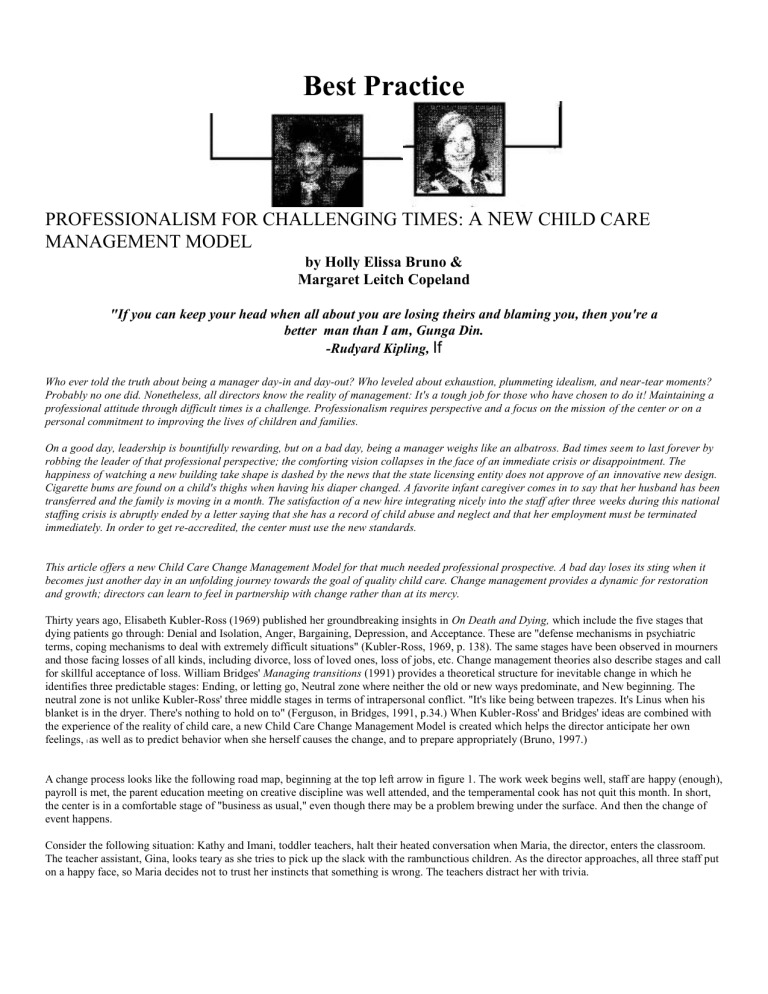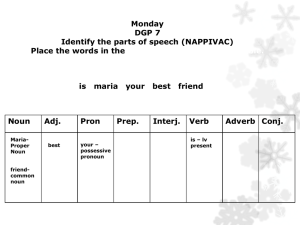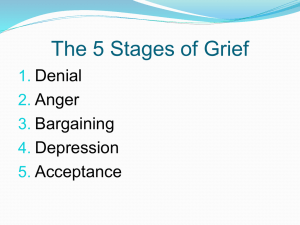Best Practice PROFESSIONALISM FOR CHALLENGING TIMES: A

Best Practice
PROFESSIONALISM FOR CHALLENGING TIMES:
A NEW
CHILD CARE
MANAGEMENT MODEL by Holly Elissa Bruno &
Margaret Leitch Copeland
"If you can keep your head when all about you are losing theirs and blaming you, then you're a better man than I am, Gunga Din.
-Rudyard Kipling,
If
Who ever told the truth about being a manager day-in and day-out? Who leveled about exhaustion, plummeting idealism, and near-tear moments?
Probably no one did. Nonetheless, all directors know the reality of management: It's a tough job for those who have chosen to do it! Maintaining a professional attitude through difficult times is a challenge. Professionalism requires perspective and a focus on the mission of the center or on a personal commitment to improving the lives of children and families.
On a good day, leadership is bountifully rewarding, but on a bad day, being a manager weighs like an albatross. Bad times seem to last forever by robbing the leader of that professional perspective; the comforting vision collapses in the face of an immediate crisis or disappointment. The happiness of watching a new building take shape is dashed by the news that the state licensing entity does not approve of an innovative new design.
Cigarette bums are found on a child's thighs when having his diaper changed. A favorite infant caregiver comes in to say that her husband has been transferred and the family is moving in a month. The satisfaction of a new hire integrating nicely into the staff after three weeks during this national staffing crisis is abruptly ended by a letter saying that she has a record of child abuse and neglect and that her employment must be terminated immediately. In order to get re-accredited, the center must use the new standards.
This article offers a new Child Care Change Management Model for that much needed professional prospective. A bad day loses its sting when it becomes just another day in an unfolding journey towards the goal of quality child care. Change management provides a dynamic for restoration and growth; directors can learn to feel in partnership with change rather than at its mercy.
Thirty years ago, Elisabeth Kubler-Ross (1969) published her groundbreaking insights in On Death and Dying, which include the five stages that dying patients go through: Denial and Isolation, Anger, Bargaining, Depression, and Acceptance. These are "defense mechanisms in psychiatric terms, coping mechanisms to deal with extremely difficult situations" (Kubler-Ross, 1969, p. 138). The same stages have been observed in mourners and those facing losses of all kinds, including divorce, loss of loved ones, loss of jobs, etc. Change management theories also describe stages and call for skillful acceptance of loss. William Bridges' Managing transitions (1991) provides a theoretical structure for inevitable change in which he identifies three predictable stages: Ending, or letting go, Neutral zone where neither the old or new ways predominate, and New beginning. The neutral zone is not unlike Kubler-Ross' three middle stages in terms of intrapersonal conflict. "It's like being between trapezes. It's Linus when his blanket is in the dryer. There's nothing to hold on to" (Ferguson, in Bridges, 1991, p.34.) When Kubler-Ross' and Bridges' ideas are combined with the experience of the reality of child care, a new Child Care Change Management Model is created which helps the director anticipate her own feelings,
I as well as to predict behavior when she herself causes the change, and to prepare appropriately (Bruno, 1997.)
A change process looks like the following road map, beginning at the top left arrow in figure 1. The work week begins well, staff are happy (enough), payroll is met, the parent education meeting on creative discipline was well attended, and the temperamental cook has not quit this month. In short, the center is in a comfortable stage of "business as usual," even though there may be a problem brewing under the surface. And then the change of event happens.
Consider the following situation: Kathy and Imani, toddler teachers, halt their heated conversation when Maria, the director, enters the classroom.
The teacher assistant, Gina, looks teary as she tries to pick up the slack with the rambunctious children. As the director approaches, all three staff put on a happy face, so Maria decides not to trust her instincts that something is wrong. The teachers distract her with trivia.
Maria, has taken Exit #1 on the Roadmap to Change,
DENIAL. Denial, as described by psychiatrists including Kubler-Ross (1969), takes familiar shapes; people think the problem will pass, or that time will heal all wounds, or that problems will miraculously disappear. Denial rarely solves anything. Phrases like,
"oh, no" or "I don't believe it" or "it must be a mistake" often accompany the denial stage. The director's heart may literally beat faster when the event takes place, but it slows when denial takes over.
Exit #2 on the Roadmap to Change is LONELINESS.
Maria returns to her office and feels lonely. This is similar to the stage which Kubler-Ross (1969) describes as Isolation, which accompanies Denial in the first stage she describes. Directors feel alone and very distant from classrooms and children when their intuition says that a problem exists that they are not facing. Denial of the problem paralyzes people from reaching out to a trusted colleague or a directors' support group for help. Maria assumes that a better director would not have problems like this. Short comings are kept private in isolation. Because of issues of confidentiality, many directors justifiably feel that they cannot discuss the issue with other staff. "It's lonely at the top," and "There's only one of me" typify this stage because few centers have a management team.
Negative self-talk drives the director to Exit #3. GUILT. Maria wonders what she had done to make the teachers stop talking and why Gina did not come to her if she was upset. Notice how easily a director can take on a staff problem as her fault. Perhaps taking the blame is easier than confronting staff (Bruno & Copeland, 1999). Guilt results from not meeting personal standards of acceptable behavior. Again, Maria assumes that a competent director would be able to talk directly with Kathy, Imani and Gina to find what the problem is. By Destination #3, the director's self-esteem is going downhill, while the problem, unresolved, picks up momentum. The director feels both anxiety and fatigue.
The final Exit on the way down is #4, DESPAIR. Failure to deal with the toddler room dilemma throws the director to the low point in her selfesteem. The worse she feels about herself as a manager, the less confident she feels to deal effectively with any of the demands on her. By now, Imani and Kathy are barely speaking and Gina has resigned. Maria has lost her professional perspective and feels at the mercy of the changes taking place.
Quitting begins to look good. She is "bottoming out" and cannot see the next turn. Maria feels completely exhausted until she begins to feel angry and says, "Wait a minute, I didn't cause this problem."
The resiliency of leadership leads to Exit #5: ANGER. Righteous Anger brings clarity, not destruction. At last, Maria begins to regain perspective.
Isn't it better to talk with Kathy and Imani than let their feud disrupt the whole center? If the mission of the center is the betterment of children and families, it is important to find a way to work this problem out. A frank conversation is a better option than avoidance. Anger, constructively channeled, recharges a director's sagging self- esteem. The problem shrinks in its power to control her; she has options. Asking other directors for advice reveals that almost everyone faces similar challenges. When she role plays the problem at the directors' support group, she hears lots of helpful approaches and healing laughter. Her energy returns!
Note that Anger comes much later in the New Child Care Management Model than it does in Elisabeth Kubler-Ross' stages. Being socialized as women as well as early childhood educators, many directors try to avoid anger, take the blame themselves and try to smooth things over which means it takes them much longer to get to the Anger stage.
The sign for Exit #6: ACCEPTANCE is clearly visible down the road from Anger. When Anger propels her to Acceptance, Maria is no longer stalled in Denial or its neighboring points of Guilt and Despair. Finally, she can envision solutions. Acceptance of the situation is empowering; individual responsibilities become clear. An honest 3-way conversation reveals that Kathy's divorce proceedings have brought out the worst in her; she decides to seek counseling and eventually apologizes to Imani. Kathy desperately needed to be confronted about separating the personal from the professional and leaving debilitating problems at the doorstep. The director relearns that not every problem at the center is about her; perspective returns. Although Kubler Ross (1969 ) cautions that "Acceptance should not be mistaken for a happy stage," in the new Child Care Change
Management Model, the relief a director feels may make her very happy because her situation is not terminal and she can get herself and the center back on the main road towards accomplishing their mission (p. 113).
This Director's journey down the roadmap of change has led to a resolution of the immediate problem. More than just the toddler room's problems have been resolved; the overall morale is uplifted by the action of the leader. Most importantly, the children are released from the shadow of the staff conflict.
Acceptance, Kubler-Ross (1969) notes, frees people to get on with life, or, for the director, to resume progress towards goals. In some cases, this may be related to a discreet issue, but in a larger sense, directors need to acknowledge the loss of the expectation that management will be problem free, resulting in a more mature vision which alleviates grieving over the death of an unattainable ideal.
How can a director remain professional throughout this change process, which can involve uncomfortable feelings? The answer is through maintaining perspective and stopping the downward journey. By acknowledging this predictable pattern of change, including labeling each stage and accompanying energy level ("Feeling guilty is exhausting and doesn't get the job done"), Directors can learn to coach themselves to turn to the goal of Acceptance from any change stage ("Wherever I am, the goal is to get to Acceptance and Action").
Consider how this new Child Care Change Management Model (Bruno 1997) offers the director ways to be effective at each stage of change, rather than to feel overwhelmed at any one stage. To paraphrase Monopoly, go directly to Acceptance, do not pass Despair, do not collect Guilt.
Consider how different the Toddler Room story would be if Maria, the director, had used the knowledge that each stage in the process of change affords an opportunity to respond professionally, by placing the problem in its proper perspective.
ACKNOWLEDGMENT of reality can replace denial. When Maria, the director, walks into a heated situation, she can pay attention to her intuition, which is telling her that there is a problem and she needs to act. Another teacher can be called in while the director privately shares her observation with Kathy and Imani, and invites their input into solutions to the problems. The impact on Gina can also be Acknowledged.
REACHING OUT for help can eliminate Loneliness. Every Director needs at least one other colleague to call for confidential advice. Inevitably, that other Director will have been in a similar situation, and learned from it. Directors' support groups provide regular opportunities for honest sharing and asking for help. Isolation is optional; Maria can find a mentor or confidant outside the center if there is no one else at the management level.
OWNERSHIP of who is responsible for what leads to an effective intervention. Yes, Maria, the director, is responsible for managing her staff competently; however, each staff member is responsible for managing her own relationship professionally.
Kathy's divorce need not enter into her working relationship with Imani; both teachers can take responsibility for managing their assistant with compassion.
TRUST in personal competence emerges each time a director faces a problem directly. If Maria asks what is going on rather than retreating to her office, she gains in personal stature. Her response does not need to be perfect or brilliant; she simply needs to be active and not passive.
CLARITY from Anger energizes the leader to sort through what the real trouble is and not absorb someone else's Guilt. Clarity means that Maria can see the role each person has played in the conflict and thus can figure out some solutions.
CONFIDENCE to do the right thing comes when the director has gotten to Acceptance. Sometimes she feels inspired to step up to the challenge at hand. Maria might now look at the staffing pattern in the toddler room to see if there is a better combination of personalities or if a staff change is needed.
In the end, getting to Acceptance early on is a service to the whole organization. Bolstered by knowledge of the internal process of change, directors can turn a difficult time into a moment of opportunity. A professional director keeps perspective and understands as other members of the organization go through the predictable stages. For example, parents leaving their children for the first time may need help getting past Guilt to
Acceptance.
Sometimes the director moves quickly through the stages, as in the toddler vignette, however sometimes the process takes much longer. When a baby died of SIDS on his first day in care, the young director found himself leading a multi-year healing process which left him much more confident as a leader. However, he was not able to help the caregiver whose Guilt and Despair stages required professional counseling. In this case, in order to get to Acceptance meant Acknowledging that the problem was larger than his training and experience had prepared him for and that he needed to reach out for help.
And sometimes, the director not only plans the change but also forces the process. One director decided to "flatten the organization" (Bruno &
Copeland, 1999) and patiently coached the head teachers as they struggled to evaluate the classroom staff. From her position of Confidence that she was doing the right thing, the director was not surprised when the first set of evaluations revealed that she had the perfect staff; she recognized Denial of the hard part of evaluation! She then helped the head teachers to Acknowledge the reality of needing to do some honest assessment of staff strengths and needs for training and change to Accept that they needed to face the responsibilities of leadership.
Finally, the confident director begins to share the Child Care Change Management Model with her staff to help them understand the predictable stages of inevitable change.
Holly Elissa Bruno, MA, JD, heads Bruno Celotto Management Consulting in Stoneham, MA. She is former Dean and Associate Professor at the
University of Maine-Augusta, and served as Maine Assistant Attorney General. Margaret Leitch Copeland, Ed.D is the Administrator for the Child
Development Bureau, the New Hampshire Department of Health and Human Services. Both teach graduate management seminars across the country for Wheelock College.
REFERENCES Bridges, W. (1991). Managing transitions: Making the most of change. Reading, MA: Addison-Wesley. Bruno, H.E.(1997). Child care management model. Unpublished manuscript. Bruno, H.E.* Copeland, M.L. (1999). Decisions! Decisions! Decision making structures which support quality. Leadership Quest, Spring. Bruno, H.E. * Copeland, M.L. (1999). If the director isn't direct, does the team have direction? Leadership Quest,
Winter Kipling, R. (1) If. Kubler-Ross, E. (1969). On death and dying. New York: Macmillan Publishing.







